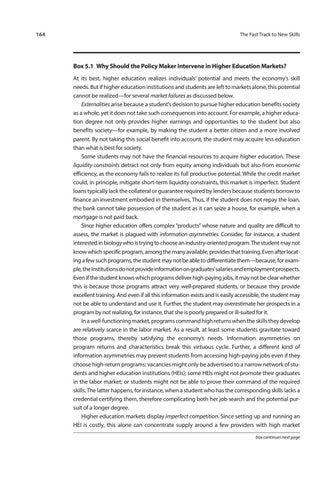164
The Fast Track to New Skills
Box 5.1 Why Should the Policy Maker Intervene in Higher Education Markets? At its best, higher education realizes individuals’ potential and meets the economy’s skill needs. But if higher education institutions and students are left to markets alone, this potential cannot be realized—for several market failures as discussed below. Externalities arise because a student’s decision to pursue higher education benefits society as a whole, yet it does not take such consequences into account. For example, a higher education degree not only provides higher earnings and opportunities to the student but also benefits society—for example, by making the student a better citizen and a more involved parent. By not taking this social benefit into account, the student may acquire less education than what is best for society. Some students may not have the financial resources to acquire higher education. These liquidity constraints detract not only from equity among individuals but also from economic efficiency, as the economy fails to realize its full productive potential. While the credit market could, in principle, mitigate short-term liquidity constraints, this market is imperfect. Student loans typically lack the collateral or guarantee required by lenders because students borrow to finance an investment embodied in themselves. Thus, if the student does not repay the loan, the bank cannot take possession of the student as it can seize a house, for example, when a mortgage is not paid back. Since higher education offers complex “products” whose nature and quality are difficult to assess, the market is plagued with information asymmetries. Consider, for instance, a student interested in biology who is trying to choose an industry-oriented program. The student may not know which specific program, among the many available, provides that training. Even after locating a few such programs, the student may not be able to differentiate them—because, for example, the institutions do not provide information on graduates’salaries and employment prospects. Even if the student knows which programs deliver high-paying jobs, it may not be clear whether this is because those programs attract very well-prepared students, or because they provide excellent training. And even if all this information exists and is easily accessible, the student may not be able to understand and use it. Further, the student may overestimate her prospects in a program by not realizing, for instance, that she is poorly prepared or ill-suited for it. In a well-functioning market, programs command high returns when the skills they develop are relatively scarce in the labor market. As a result, at least some students gravitate toward those programs, thereby satisfying the economy’s needs. Information asymmetries on program returns and characteristics break this virtuous cycle. Further, a different kind of information asymmetries may prevent students from accessing high-paying jobs even if they choose high-return programs: vacancies might only be advertised to a narrow network of students and higher education institutions (HEIs); some HEIs might not promote their graduates in the labor market; or students might not be able to prove their command of the required skills. The latter happens, for instance, when a student who has the corresponding skills lacks a credential certifying them, therefore complicating both her job search and the potential pursuit of a longer degree. Higher education markets display imperfect competition. Since setting up and running an HEI is costly, this alone can concentrate supply around a few providers with high market box continues next page

